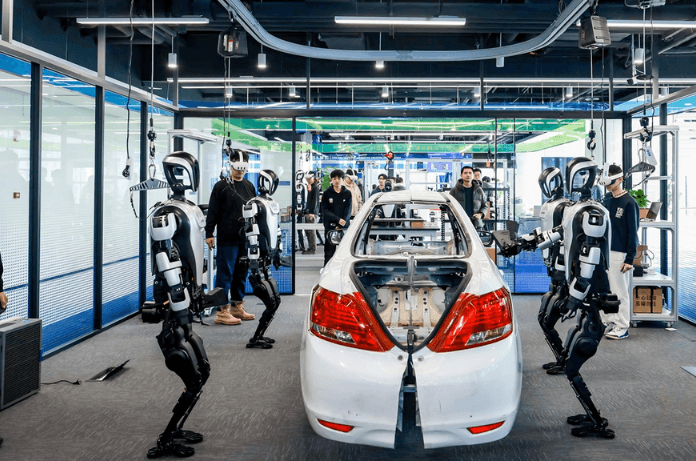China is making waves in the world of technology, and this time, it’s all about humanoid robots. On Tuesday, the nation marked a major milestone by opening its very first heterogeneous humanoid robot training center – Humanoid Robot Kylin Training Ground in Shanghai. Humanoid Robot (Shanghai) Co. owns this training center. It’s more than just a facility. It’s a statement that China is serious about leading the global humanoid robot industry.
The Kylin training ground is now China’s largest training center for humanoid robots. This ground can accommodate 100 humanoid robots. The ambition doesn’t stop there; the center plans to train 1,000 general-purpose robots parallelly by 2027, said Yang Zhengye, the company’s marketing director.
Let’s dive into the details of how this initiative revolutionizes humanoid robotics.
Kylin Training Ground: Humanoid Robot Training Facility
The Kylin training ground is one of the critical infrastructures that will drive innovation and practical application in the humanoid robot sector. This training field is going to encourage collaboration among businesses and industries. It offers tailored training scenarios for sectors like intelligent manufacturing and public services.
Yang Zhengye says this training ground is a centralized hub for technological innovation and industrial progress. This ground brings businesses together, it’s creating a space where ideas can thrive and robots can become smarter and more useful.
Data-Driven Training At Kylin Training Ground
One of the ambitious goals of the Kylin training ground is to collect 10 million high-quality physical data entries by the end of 2025. This data will be used to teach general-purpose humanoid robots. Thereby making them more adaptable and capable. To achieve this, the facility is working closely with Shanghai-based robot manufacturers like Zhiyuan Robotics and Kupas Technology Co.
“Data is the key to smarter robots,” said Jiang Lei, the chief scientist at the innovation center. By building one of the most diverse embodied datasets in the industry, China aims to create robots that can think, learn, and adapt in ways we have never seen before.
Why Humanoid Robots Matter
China’s push for humanoid robots isn’t just about technology and it’s also about solving real-world problems. With an aging population, the need for smarter, more adaptable robots has never been greater. Jiang Lei explained that humanoid robots, combined with advanced technologies like autonomous driving and embodied intelligence. They can help address the challenges of an aging society.
These robots aren’t just about doing repetitive tasks; they are about assisting in areas like healthcare, elderly care, and public services. “Humanoid robots are the future, and they are here to make our lives better,” Jiang said.
Future Of Humanoid Robots
Zhejiang Province in East China is also stepping up its game. The local government plans to produce 20,000 humanoid robots annually by 2027, aiming for an industry scale of 20 billion yuan. These robots will feature greater intelligence, efficiency, and modularity, making them even more versatile for industrial applications.
China’s efforts in humanoid robotics aren’t just about competing with other countries. They are about shaping the future of technology. As Jiang Lei addressed, robotics and artificial intelligence are key to addressing global challenges like aging populations and workforce shortages. By investing heavily in these fields, China is positioning itself as a leader in the global tech race.
Meet the Next-Gen Robot: Deep Snake
As part of its efforts, the innovation center – Kylin plans to launch the 2.0 version of its humanoid robot, called Deep Snake. This next-gen robot will showcase advanced technologies like linear joint actuators, which improve functionality and performance reported GT.
“Technology is evolving fast, and the humanoid robot industry is now in the fast lane,” said Jiang. Thanks to supportive government policies and rapid technological advancements, the future of humanoid robots looks brighter than ever.
This explosive growth is fueled by policy support from local governments. For instance, Beijing’s government has prioritized future industries like humanoid robots in its 2025 development plan, as mentioned in the government work report presented at the 16th Beijing Economic Summit.
Humanoid Robots in Sports
If you think humanoid robots are just for factories or research labs, think again. China is planning to host the first-ever humanoid robot half marathon in April this year. One highlight of the event will be humanoid robots like Tiangong are going to compete with humans in the half marathon.
Standing at 1.63 meters tall, Tiangong can run at a steady pace of 6 kilometers per hour, proving just how far humanoid robots have come. This is just one example of how China is combining innovation with public engagement to make robotics exciting for everyone.
Conclusion: A New Era of Humanoid Robots
Kylin Training Ground, China’s first humanoid robot training center in Shanghai is more than just a milestone and it’s a vision for the future. With plans to train 1,000 robots by 2027, and collect 10 million data entries, the country is setting the stage for a robotics revolution.
The combination of advanced technology, strong government backing, and ambitious goals makes this an exciting time for the humanoid robot industry. Whether it’s solving real-world problems or showcasing their abilities in sports games, humanoid robots are here to stay and they’re only going to get smarter.

